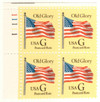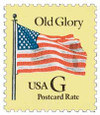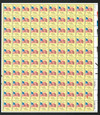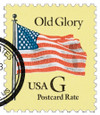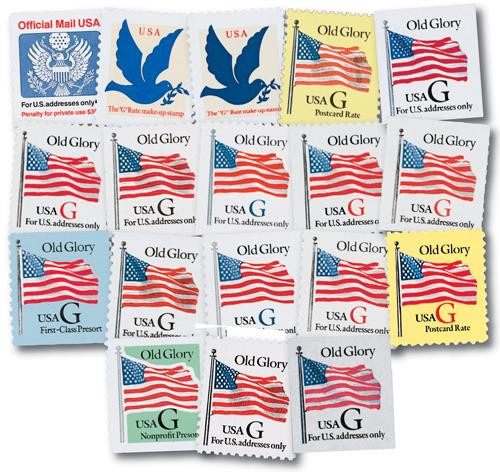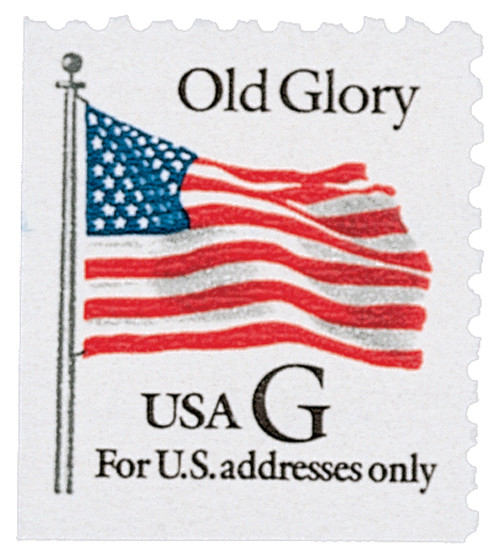
# 2879 - 1994 20c G-rate Old Glory
U.S. #2879
1994 G-rate Old Glory
- Issued as a non-denominated stamp
- Yellow background made it easily distinguished as postcard rate
- The yellow ink bleeds onto the selvage
Stamp Category: Definitive
Set: G Series
Value: 20¢ Postcard Rate
First Day of Issue: December 13, 1994
First Day City(s): Washington, DC
Quantity Issued: 354,000,000
Printed by: Bureau of Engraving and Printing
Printing Method: Gravure Printing (7-color Andreotti gravure webfed press)
Format: Sheet stamp. Panes of 100, vertical, 10 across, 10 down. Gravure printing cylinders of 400 subjects (20 across, 20 around).
Perforations: 11.2 x 11.1
Selvage Markings: “© UNITED STATES/POSTAL SERVICE 1992.” “USE CORRECT ZIP CODE”
Why the stamp was issued: The USPS issued this G series general-use stamp for the new postcard rate that would take place in 1995.
About the stamp design: This stamp was designed by Ronald Sharpe who was the first African-American Banknote Designer at the Bureau of Engraving and Printing. The black “G” on the stamp indicates it was printed by the Bureau of Engraving and Printing.
Special design details: The yellow ink of the background bled onto the selvage for both printers. The BEP panes only bled a small amount and the marginal inscriptions were still legible.
About the printing process: The stamp was printed by the Bureau of Engraving and Printing on their 7-color Andreotti gravure webfed press (601). This Italian-made press was acquired by the BEP in 1970 and was the workhorse making all the multicolored stamps around that time period.
First Day City: Most definitive stamps that don’t receive a first day ceremony get issued in Washington, DC which is home of the United States Postal Headquarters.
About the G-rate Series: The USPS issued G-rate stamps to aid in the transition of a new postal rate. All, except two, G-rate stamps picture the US Flag with “Old Glory” in text above it, the other two are blue doves. They released eighteen different versions of G-rate stamps. These came in six different formats, in five varied rates, from five different printers! These include six different sheet stamps, six coils, four booklets, and two self-adhesives. This made the G-rate stamps printed by more printers and in more formats that any previous rate change stamp.
History the stamp represents: The US Postal Service started making rate change stamps, or “contingency” stamps as they were known, in 1978 with the A-rate which was fifteen cents. They wanted to make sure they had stamps to fulfill any rate change, gap in prices, or any combination. In early 1981 the B-rate stamps were issued to make up eighteen cents. At the end of 1981 the C-rate for twenty cents was issued. A few years went by before the D-rate came along in 1985. With the E-rate collectors saw a shift from an eagle with the color stamp to the image reflecting the letter, E having an Earth on the stamp in 1988. The F make-up-rate was only four cents and depicted a tulip on the stamp. G-rate was in 1995 and H followed in 1999. Collectors thought they were going to keep going following the rest of the alphabet, but H was where it ended. Many joked that the US Postal Service didn’t want to issue an I-rate stamp, but the reasons behind the end was never clear.
U.S. #2879
1994 G-rate Old Glory
- Issued as a non-denominated stamp
- Yellow background made it easily distinguished as postcard rate
- The yellow ink bleeds onto the selvage
Stamp Category: Definitive
Set: G Series
Value: 20¢ Postcard Rate
First Day of Issue: December 13, 1994
First Day City(s): Washington, DC
Quantity Issued: 354,000,000
Printed by: Bureau of Engraving and Printing
Printing Method: Gravure Printing (7-color Andreotti gravure webfed press)
Format: Sheet stamp. Panes of 100, vertical, 10 across, 10 down. Gravure printing cylinders of 400 subjects (20 across, 20 around).
Perforations: 11.2 x 11.1
Selvage Markings: “© UNITED STATES/POSTAL SERVICE 1992.” “USE CORRECT ZIP CODE”
Why the stamp was issued: The USPS issued this G series general-use stamp for the new postcard rate that would take place in 1995.
About the stamp design: This stamp was designed by Ronald Sharpe who was the first African-American Banknote Designer at the Bureau of Engraving and Printing. The black “G” on the stamp indicates it was printed by the Bureau of Engraving and Printing.
Special design details: The yellow ink of the background bled onto the selvage for both printers. The BEP panes only bled a small amount and the marginal inscriptions were still legible.
About the printing process: The stamp was printed by the Bureau of Engraving and Printing on their 7-color Andreotti gravure webfed press (601). This Italian-made press was acquired by the BEP in 1970 and was the workhorse making all the multicolored stamps around that time period.
First Day City: Most definitive stamps that don’t receive a first day ceremony get issued in Washington, DC which is home of the United States Postal Headquarters.
About the G-rate Series: The USPS issued G-rate stamps to aid in the transition of a new postal rate. All, except two, G-rate stamps picture the US Flag with “Old Glory” in text above it, the other two are blue doves. They released eighteen different versions of G-rate stamps. These came in six different formats, in five varied rates, from five different printers! These include six different sheet stamps, six coils, four booklets, and two self-adhesives. This made the G-rate stamps printed by more printers and in more formats that any previous rate change stamp.
History the stamp represents: The US Postal Service started making rate change stamps, or “contingency” stamps as they were known, in 1978 with the A-rate which was fifteen cents. They wanted to make sure they had stamps to fulfill any rate change, gap in prices, or any combination. In early 1981 the B-rate stamps were issued to make up eighteen cents. At the end of 1981 the C-rate for twenty cents was issued. A few years went by before the D-rate came along in 1985. With the E-rate collectors saw a shift from an eagle with the color stamp to the image reflecting the letter, E having an Earth on the stamp in 1988. The F make-up-rate was only four cents and depicted a tulip on the stamp. G-rate was in 1995 and H followed in 1999. Collectors thought they were going to keep going following the rest of the alphabet, but H was where it ended. Many joked that the US Postal Service didn’t want to issue an I-rate stamp, but the reasons behind the end was never clear.







